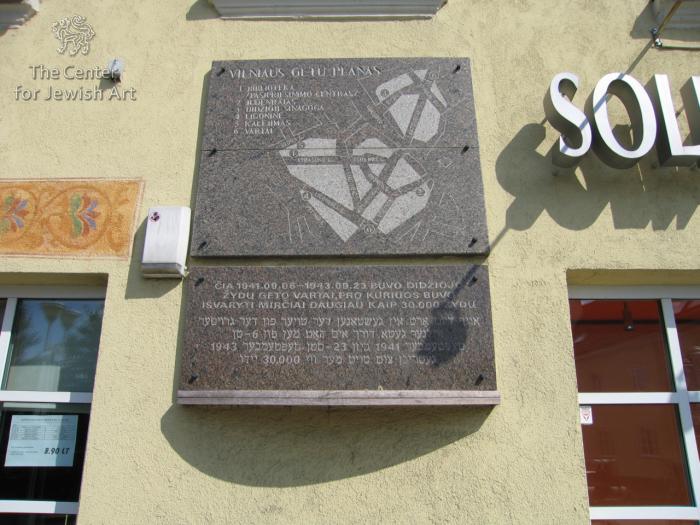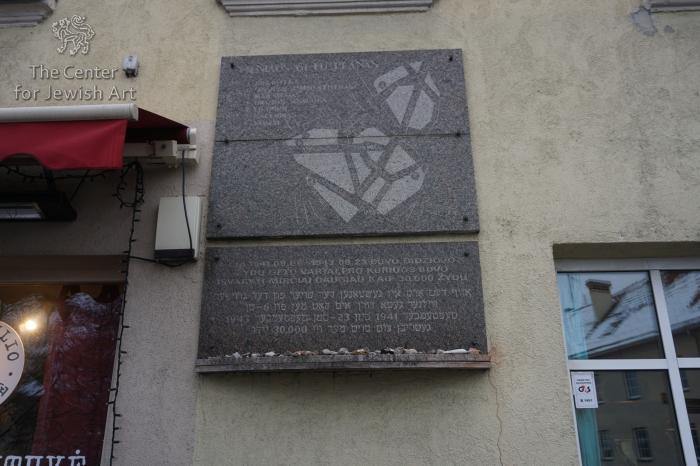Obj. ID: 14283 Memorial plaque at the entrance to the Large Ghetto in Vilnius, Lithuania, 1993

Who is Commemorated?
Victims of the Large Ghetto in Vilnius
Description:
Two granite plaques are attached to the wall of the house at 18 Rūdninkų St. marking the location of the gate to the Large Ghetto (sometimes called the First Ghetto) of Vilnius. The upper plaque depicts the plan of the Small and Large Ghettos. The lower plaque contains identical inscriptions in Lithuanian and Yiddish.
Inscription:
Lithuanian:
Čia 1941.09.06 – 1943.09.23 buvo didžiojo
žydų geto vartai, pro kuriuos buvo
išvaryti mirčiai daugiau kaip 30.000 žydų
Yiddish:
אויף דעם אָרט איז געשטאנען דער טויער פון דער גרויסער
ווילנער געטאָ. דורך אים האָט מען פון 6-טן
סעפטעמבער 1941 ביזן 23-סטן סעפטעמבער 1943
געטריבן צום טויט מער ווי 30.000 ייּדן
Translation: In this place, stood the gate of the Large Ghetto of Vilnius. Through it, from September 6th 1941 to September 23rd 1943, more than 30,000 Jews were driven to their deaths.
Lithuanian inscription on the plaque with the ghetto plan:
Vilniaus getų planas
1. Biblioteka (pasipriešinimo centras)
2. Judenratas
3. Didžioji sinagoga
4. Ligoninė
5. Kalėjimas
6. Vartai
Translation: Plan of the Vilnius Ghetto:/ 1. Library (the center of resistance) / 2. Judenrat / 3. Great Synagogue / 4. Hospital / 5. Prison / 6. Gates
Commissioned by
Vilna Gaon Jewish State Museum and the Jewish Community of Lithuania, on the initiative of Vilnius Jewish historian Genrikh Agranovsky, and financed by the Vilnius municipality (Agranovskii 1994; Guzenberg 2013).
The Large Ghetto in Vilnius was established on September 6th and 7th, 1941 and initially contained about 29,000 inmates. Officially, only 12,000 Jews remained in the ghetto at the end of November 1941, but several thousands more were in hiding. The ghetto was "liquidated" on September 23, 1943, when about 8,000 Vilnius Jews were taken out and either murdered or sent to work camps in Estonia. About two thousand more hid in the ghetto houses. Only two to three thousand prisoners of the ghetto survived (Guzenberg 2021, p. 186).
The plaque was unveiled on September 23, 1993, the 50th anniversary of Large Ghetto's annihilation. It was installed on the initiative of Vilnius Jewish historian Genrikh Agranovsky and financed by the municipality (Guzenberg 2013). As a photograph made by the expedition of the Center for Jewish Art in 1993 testifies, the plaque with the plan of the ghettos was added at a later date.
Agranovskii, Genrikh, "Vekhi istorii," in Žydų muziejus. Evreiskii muzei. The Jewish Museum, ed. Evsey Ceitlin (Vilnius: Lietuvos valstybinis žydų muziejus, 1994), 268-270.
Agranovskii, Genrikh and Irina Guzenberg. Vilnius: Po sledam Litovskogo Ierusalima. Pamiatnye mesta ereiskoi istorii i kul’tury, 2nd ed. (Vilnius: The Vilna Gaon Jewish State Museum, 2016)., 164.
Guzenberg, Irina, Vilnius: Traces of the Jewish Jerusalem of Lithuania. Memorable Sites of Jewish History and Culture. A Guidebook (Vilnius: Pavilniai, 2021)., 170.
Guzenberg, Irina. Vilnius: Pamiatnye mesta evreiskoi istorii i kul'tury (Vilnius: Pavilniai, 2013)., 51.
Levinson, Yosif, Skausmo knyga. The Book of Sorrow. Dos bukh fun veytik. Sefer ha-keev (Vilnius: VAGA Publishers, 1997)., 52-53.











